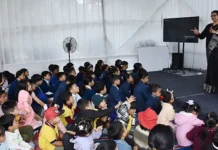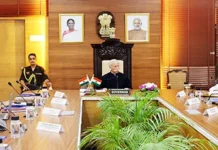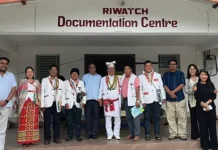[Prem Chetry]
BOMDILA, 29 May: A tagged male Bugun Liocichla (Liocichla bugunorum) – an endemic and critically endangered bird species – was resighted after at least nine years at Glow Bari under the Singchung Bugun Village Community Reserve (SBVCR) in West Kameng district.
Umesh Srinivasan, assistant professor at the Centre for Ecological Sciences, Indian Institute of Science, Bengaluru, who has conducted 15 years of research in Bompu, expressed delight at the sighting of one of the birds that was tagged in 2016. He noted, “Based on what is known about the closely-related sister species, the Emei Shan liocichla, we estimate the Bugun liocichla’s lifespan to be around 8 to 12 years, provided they survive the first year. Most mortality in these babbler species occurs during the egg and nestling stages, due to predation or brood parasitism.”
Previously, the recorded population of the Bugun liocichla was just 20 individuals, confined to the Glow Bari-Sharuwa region. However, recent sightings have become more frequent at Ramalingam, and rare sightings have been reported at Bompu. It is now claimed that the population has increased to approximately 200 individuals.
However, according to experts, along with manual observations, there is a need for scientific monitoring and enumeration of this rare species and its habitats to ensure their conservation.
Lobsang Tsering, who has 19 years of birding guide experience, said, “It was during a recent bird-watching trip with my clients that we sighted a tagged Bugun liocichla, which had been tagged nine years ago.”
The sighting of this tagged individual is a positive sign, indicating that its habitat remains intact due to increasing awareness, research, and conservation efforts by the SBVCR and the Forest Department. However, much remains unknown about this elusive species, underscoring the need for further research.
The Bugun liocichla was first sighted in 1995 by astrophysicist and birdwatcher Ramana Athreya. At the time, the bird did not match any known species, prompting further investigation.
When asked, Athreya said that, after nearly a decade of intermittent observations and study, the bird was described as a new species in 2006, using photographs, feathers, and audio recordings, without collecting a physical specimen due to the bird’s rarity. This discovery was significant as it marked the first new bird species described in India since independence in 1947.
In 2017, the Bugun community of Singchung village established the Singchung Bugun Village Community Reserve to protect the species. This community-led initiative has been instrumental in the remarkable recovery of this rare bird’s population.




